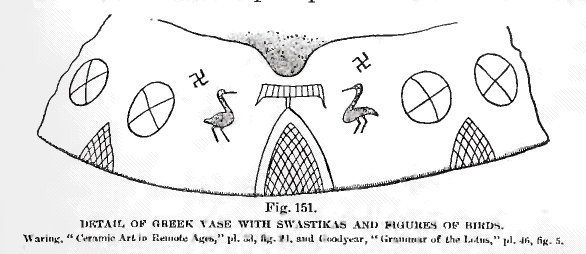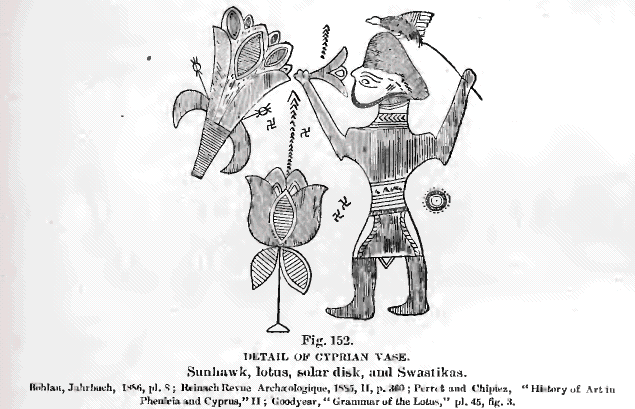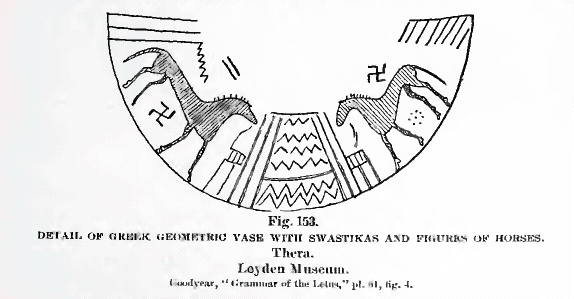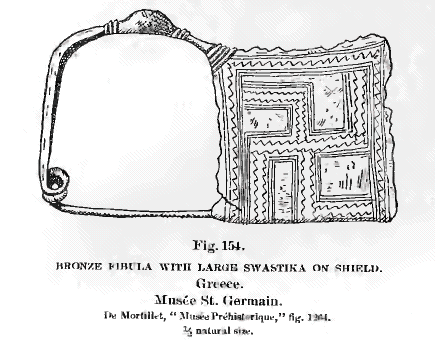|
The Swastika
Dispersion of the Swastika
Page 52
the minds of their respective
artists. [2] Single specimens are no evidence of custom. This is a principle
of the common law which has still a good foundation,

and was as applicable in those days as it is now. The transition form
the spiral of the Greek fret and from the Greek fret to the Swastika can
be shown only by the existence of the custom or habit of the artist to
make them both in the same or adjoining epochs of time, and this is not
proved by showing a single specimen. [3] If a greater number of

specimens were produced, the chain of evidence would still be incomplete,
for the meander of the Greek fret will, as has just been said, be found
impossible of transition into the meander Swastika. It (the Swastika)
does not extend itself into a band, but if spread at all, it spreads in
each of the four directions (figs.
21 and 25). the transition
will be found much easier from the

Greek meander fret to the
normal Swastika and from that to the meander Swastika than to proceed
in the opposite direction. Anyone who doubts this has but to try to make
the Swastika in a continuos or extended band or line (fig.
26), similar to the Greek fret.

Figs.
133 and 134, from Naukratis,
afford palpable evidence of the different origin of the Swastika and the
Greek fret. Evidently Grecian vases, though found in Egypt, these specimens
bear side by side examples of the fret and the Swastika used contemporaneously,
and both of them complete and perfect. If one had been parent of the other,
they would have belonged to different generations and would not have appeared
simultaneous use is in fig. 194,
which represents an Etruscan vase (1)
ornamented with bronze nail heads in the form of
Figs 155, 156
and 157
ENDNOTES:
1.
Matérianx pour l'Histoire Primitive et Naturelle de l'Homme, XVIII,
p. 14. [Back]
<< Previous Page
Next
Page >>
© 2004-2007 Northvegr.
Most of the material on this site is in the public domain. However, many people have worked very hard to bring these texts to you so if you do use the work, we would appreciate it if you could give credit to both the Northvegr site and to the individuals who worked to bring you these texts. A small number of texts are copyrighted and cannot be used without the author's permission. Any text that is copyrighted will have a clear notation of such on the main index page for that text. Inquiries
can be sent to info@northvegr.org.
Northvegr™ and the Northvegr symbol are trademarks and service marks
of the Northvegr Foundation.
|
> Northvegr™ Foundation
>> About Northvegr Foundation
>> What's New
>> Contact Info
>> Link to Us
>> E-mail Updates
>> Links
>> Mailing Lists
>> Statement of Purpose
>> Socio-Political Stance
>> Donate
> The Vík - Online Store
>> More Norse Merchandise
> Advertise With Us
> Heithni
>> Books & Articles
>> Trúlög
>> Sögumál
>>
Heithinn Date Calculator
>> Recommended Reading
>>
The 30 Northern Virtues
> Recommended Heithinn Faith Organizations
>> Alfaleith.org
> NESP
>> Transcribe Texts
>> Translate Texts
>> HTML Coding
>> PDF Construction
> N. European Studies
>> Texts
>> Texts in PDF Format
>> NESP Reviews
>> Germanic Sources
>> Roman Scandinavia
>> Maps
> Language Resources
>> Zoëga Old Icelandic Dict.
>> Cleasby-Vigfusson Dictionary
>> Sweet's Old Icelandic Primer
>> Old Icelandic Grammar
>> Holy Language Lexicon
>> Old English Lexicon
>> Gothic Grammar Project
>> Old English Project
>> Language Resources
> Northern Family
>> Northern Fairy Tales
>> Norse-ery Rhymes
>>
Children's Books/Links
>> Tafl
>> Northern Recipes
>> Kubb
> Other Sections
>> The Holy Fylfot
>> Tradition Roots

Please Visit Our Sponsors
- Référencement
- Alfaleith.org - Heithni, Viðartrú
- Odin's Journey
- Baman - Iceland/Aboriginal Australia
- Biker's Booty
- Création site Internet Paris
- Pagan T-shirts
- Appartements
- Chalets au Québec
- Logo Designers
- Web Design
- Appartements Montreal
- Espace Bureau Montreal
- London Tours
- Spanish Property Legal Advice
- Multi Pret Hypotheque
- Company Logo Design
- Wiccan T-shirts
- Art Gallery, Painting artists
- free logo design reviews
- Heathen, Heathenism, Norse Pagan
- Logo design by LogoBee
- Pagan Shirts
- Norse Pagan Religion
- Triumph, BSA, Norton, Euro Motorcycles - Accessories
- Logo Maker
- Logo Design - Business Logos, Inc.
- Logo Design - Logo Maker
- Create A Website
- Wiccan Shirts
- Mortgages
- Multi-Prêts Hypothèques
- Viking T-shirts
- Hewlett Packard Ink Cartridges
- Indian Recipes
- Logo Design London
- Logo Design
- Logo Design UK
- Subvention et financement PME
- Heathen T-shirts
- Medical Alert, Emergency response
- orlando hotels
- Slot Machines for Vikings
- Norse Pagan Clothing and Merchandise
- New Homes
- Branding Irons
- Bachelor Degree Online
- Online Degree
- College Degree
- Heathen, Viking and Norse Texts
- Création site Internet
- Montreal Web Design
- Free Dish Network Satellite TV
- Discount ink cartridge & laser cartridge
- DUI Lawyers & DWI Attorneys
- Promotional Products
- Ready-Made Company Logos
- Canadian Art Dealer
- Best CD Rates
- Laser Toner Cartridge
- Logotyper & Grafiska Profilprogram
- Banner Design
- Custom Logo Design
Web site design and coding by Golden Boar Creations
|
|






